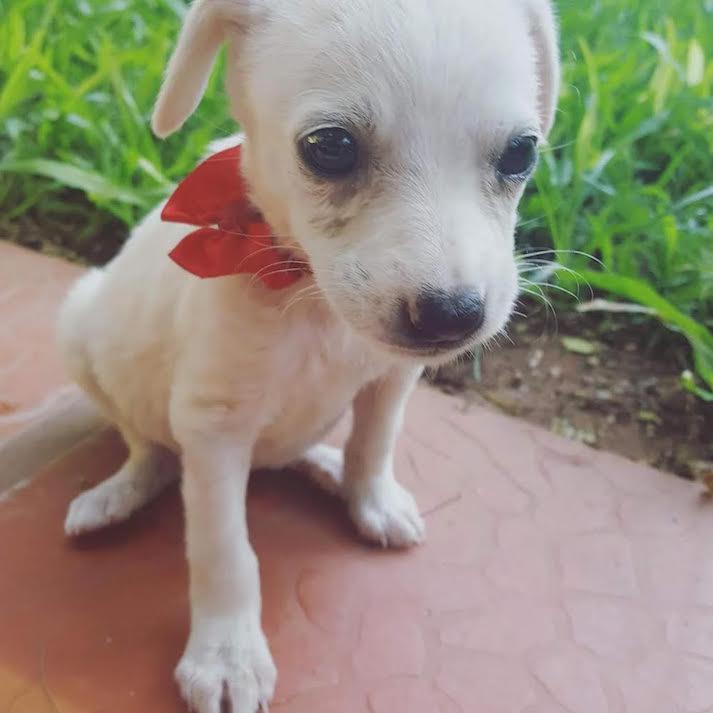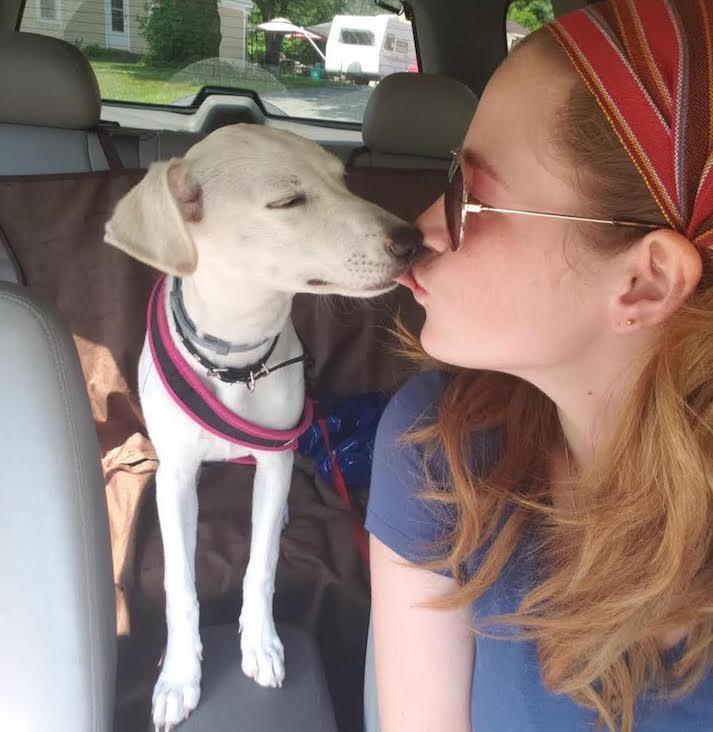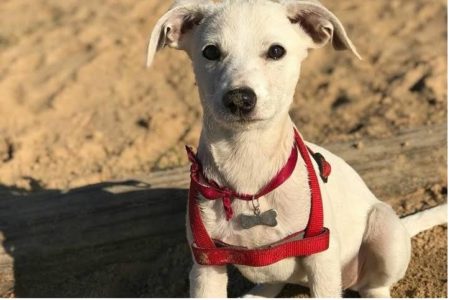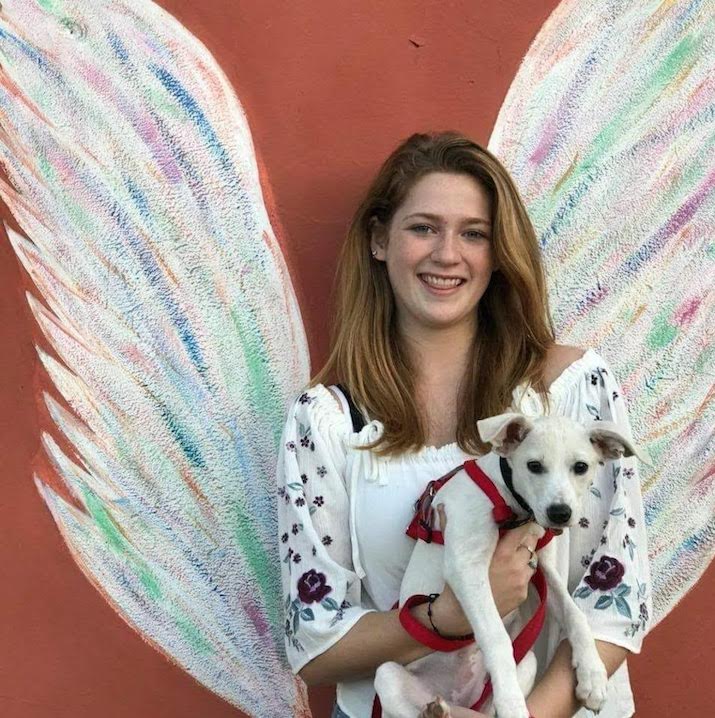Mason Archambeault, 17, was on a mission trip to Paraguay for 11 months with Rotary International Youth Exchange program and living with a host family when she found Chupita, who was “a tiny white ball of fur and fleas, lost and alone on the side of a dangerous highway in Capiatá.”
“We took her to the vet and researched how to take care of this days old puppy. Later that evening, Chupita fell from the third floor balcony. We thought all hope was lost when we came home and found she was gone,” said Mason.
About an hour later she was found outside the house wrapped in a soft pink blanket, unharmed and hungry. She had miraculously fallen from the balcony and landed in a soft blanket left beside the building. Chupita was bottle fed milk for a week and learned to drink from a bowl by week two. By two months old, she was eating warm kibble and milk mixed with water.”

Even though Mason had full days–attending the local high school, volunteering in a local maternity hospital, attempting to spread world peace—she took on raising a puppy. From bottle feeding her and waking up to go pee every hour in the night, to teaching her puppy, “manners,” she came to love the dog so much that she couldn’t bear to leave her behind.
“I couldn’t just leave her in Paraguay. She thought I was her mom! She relied on me for survival and nurturing,” Mason said. “She would have died on the streets without me or, at best, would have survived by eating trash from the streets for the rest of her life. After a long phone call with my mom we decided that if I could arrange her flight, she would figure out a plan to take care of Chupita in the US.”
She started her research on how to bring her back to the states—and the sheer magnitude of what that undertaking meant could only have been seen through by the world’s strongest case of puppy love.

Mason—did you know what to expect when you started the whole process?
Not at all. When we made the decision to investigate the process, she was only about a month old, and was so small that when I put her on the scale, the needle didn’t budge. I researched a few options: Since she was so small, I figured I could keep her in a mesh-like dog bed and stuff her under my seat for the 22 hours of travel from Paraguay to New York.. Unfortunately, although my airline, Aerolinias Argentina, allowed for onboard pets for short international travel between Asuncion and Buenos Aires, they would not allow for Chupita to be in the cabin for the longer North American bound flight. To travel from Buenos Aires to JFK, Chupita would have to travel via cargo shipping. Since my connection in Buenos Ares was too quick, this transfer would have been impossible.
But you decided to keep going….
After talking with other people who had shipped pets abroad, I researched various live cargo shipping options. Shipping Chupita seemed to be the best option as she would be shipped with other animals in an air conditioned, pressurized part of the plane. She would be given food or water if needed, and her flight would be scheduled to minimize layovers. If the scheduled layovers were longer than anticipated, she would be housed temporarily in an air conditioned building. As I researched more about live animal cargo shipping, this seemed like the safest and most reliable option. I contacted Copa Airlines, and a few travel agents who specialized in pet travel. They all supplied me with a lot of information including the hardest thing to take in, the cost.

How much did it cost you?
About $1,000 for a doggie plane ticket. After living a year in Paraguay where the dollar is extremely strong, this was really expensive. But in the end, my love for Chupita was too much to think about the financial part of it… although my parents tried to convince me I had better things to spend my money on (including a trip to Machu Picchu or college in the Fall). I knew that leaving her behind was not an option, so I created a GoFundMe account to help defer the cost.
What did your checklist look like, once you made that decision?
Chupita needed the following in order to reserve a place on the plane: An approved air travel kennel; The dimensions of the air certified pet kennel; A large enough kennel to sit/down/turn; The dog’s measurements; The person retrieving the dog must be able to contact Copa Cargo in JFK beforehand to arrange the pick up; Delivery fee at JFK of $100 (cash); Supply front and side pictures with dog and kennel, and more. We needed certifications from the vet; all documents needed to be turned in to the agency at least two work days before the flight; a medical check 10 days prior; vet appointment times for government papers; a rabies vaccine 30 days before departure; English health certificate; Health statement printed on the vets letterhead stationary; and all documents had to be signed and stamped by the vet, by SENESCA, by the Ministry of Foreign Relations, and myself.
And those weren’t even your main challenges, you mentioned…
The language barrier was a big one. This all took place in my second language. Even though the travel agent spoke English, every other person I had to work with spoke Spanish. I consider myself pretty fluent in Spanish but translating our technical needs and Chupita’s story to everyone was an ultimate test. Finding the kennel with correct proportions was also one of the most difficult things to accomplish. We got lucky and actually found one on the top of a few pallets in the middle of the biggest market place in the capital city of Asuncion. There was only one in the entire marketplace and it was spotted by a friend of my host family only two weeks before Chupita’s flight.

As an exchange student who went to school full time, had a host family who worked full time, and relied upon public transportation that didn’t allow pets, I struggled to get her to the vet, which was about an hour away from my house. I ended up wrapping Chupita up in a scarf around my stomach like a baby to hide her from everyone, and took the bus to the vet. As if our timeline wasn’t tight enough, we ran into problems the day of Chupita’s flight with her paperwork. The vet had put the wrong date on the paper from the rabies vaccine and it wasn’t approved for entry into NYC. With this information, we had to change the paperwork and get it signed by all of the officials on the day of Chupita’s flight.
Another challenge I faced was the form of payment. The travel agency required cash or money transfer in USD or Guarani. Paying $780 USD in cash in Paraguay was almost impossible because it was not the local currency. Paying this large sum with Guarani was also just as difficult because of the amount of bills needed was tremendous. It would be like showing up to pay your airline ticket in the U.S. with a briefcase of bills.
What was the most unexpected part of the process?
Getting the government stamps of approval was difficult. If any one of the many people who helped me hadn’t done so, Chupita’s story would be very different. When I arrived at the Ministry of Foreign Relations, the security guard told us we needed to go to a different place six blocks away. When we arrived there, at 12:06pm, the office had closed. Luckily a worker’s child was handing out tickets, kind of like at the DMV, and he gave one to me by accident.
His father, the manager, was so mad, but when I shared Chupita’s story and my timeline, they fell in love with her, and wanted to help me. They hacked onto the government computers to access the file I needed, printed it, signed it, and sent me out the door. When doing this, they told me to only speak in English to hide what was going on from the other people waiting in line who were unable to get their papers done because of the office closing. I felt like a secret agent!

Martha, how did you feel about everything?
I was extremely skeptical of the situation, and assumed she would be returning to the US, heartbroken, but not a dog owner. Likewise, I assumed I would be enjoying an empty nest as she headed off to college in the fall, not training a six month old puppy. When I visited her and her family in Paraguay, I realized that she was more than determined to adopt Chupita. My cousin, my son, and I spent five days in Paraguay where we were able to get to know the three month old puppy. It was only a matter of hours before I realized my plans were not going to become reality.
From our small town in Vermont, John F. Kennedy Airport in New York City is anywhere from five to ten hours away depending on traffic. With so many variables, I was nervous about arriving on time. I was also nervous about what shape Chupita would be in upon arrival. Would she be traumatized? Would she be sick? Would she need vet care? How would I clean her before making the return trip to Vermont? Thankfully, I came across a New York Times article about the Pet Oasis at The ARK at JFK. I was happy to learn that the Pet Oasis provided all sorts of services related to the international shipping of animals.
Do you have any advice for folks traveling who may want to bring a dog back with them to save their lives?
Martha:
Mason faced many challenges in Paraguay to keeping Chupita—she was an exchange student and a guest to three families throughout the year. When she transitioned to her third family, so did Chupita. They also went above and beyond to allow Mason to keep her. While, they didn’t have a dog of their own, they provided a warm environment for Chupita. We recently heard that they adopted another dog shortly after Mason’s departure.
Read, re-read, and read again the documentation provided by the CDC and US Department of State. The regulations vary from country to country, and legislation does change. I would highly recommend hiring a stateside organization such as the The ARK at JFKto help with the paperwork.

They are well versed in the rules and requirements and can do much of the legwork for you. In our case, they spotted a typo on one of the certified documents that would have prevented Chupita from entering the U.S. Even though this caused major stress on Mason at the last minute, it was better to know beforehand.Chupita has adjusted well to our family and enjoys living the life of puppy luxury in the green mountains of Vermont. We joke that she was the Paraguay steet puppy who found the golden ticket. Mason’s grandfather is recently retired and was smitten with the puppy since her pick-up in New York.
Mason: There is always a way out and an unlimited amount of people who want to help. Be prepared for anything and discount any ideas. Keep all options available, and be grateful for the people who help you along the way. Talking to customs was never something I had to worry about. When I found a travel agent for Chupita, he gave me all of the information I needed in order to bring her to the U.S. The entire process was like a big scavenger hunt with the prize being a perfect puppy. I did the paperwork, and he covered talking to the airline, airport, and customs. I highly recommend Andres Santacrus from Airemar in Asuncion, Paraguay.
Although the process seems impossible, it’s only impossible if you don’t have hope.

